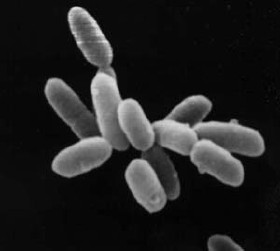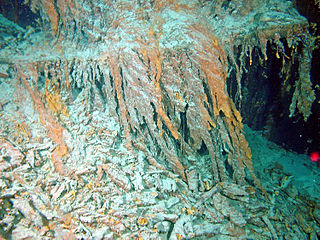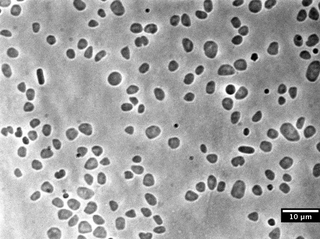Related Research Articles

Halobacterium is a genus in the family Halobacteriaceae.

Haloarchaea are a class of the Euryarchaeota, found in water saturated or nearly saturated with salt. Halobacteria are now recognized as archaea, rather than bacteria and are one of the largest groups. The name 'halobacteria' was assigned to this group of organisms before the existence of the domain Archaea was realized, and while valid according to taxonomic rules, should be updated. Halophilic archaea are generally referred to as haloarchaea to distinguish them from halophilic bacteria.
Halopiger is a genus of archaeans in the family Halobacteriaceae that have high tolerance to salinity.
In taxonomy, Haloplanus is a genus of the Halobacteriaceae.
In taxonomy, Halorhabdus is a genus of the Halobacteriaceae.
Halorubrum is a genus in the family Halobacteriaceae. Halorubrum species can be found in the Dead Sea, Lake Zabuye and other waters with high salt concentration.
In taxonomy, Halovivax is a genus of the Halobacteriaceae. Some species of Halovivax are halophiles and have been found in Iran's Aran-Bidgol hypersaline lake.

Halomonas titanicae is a gram-negative, halophilic species of bacteria which was discovered on rusticles recovered from the wreck of the RMS Titanic. Cristina Sánchez-Porro et al. first isolated the bacterium in 2010 from a sample of rusticle obtained from the RMS Titanic in 1991. One of the researchers, Henrietta Mann has estimated that the action of microbes like Halomonas titanicae may bring about the total deterioration of the Titanic by 2030. While the bacteria have been identified as a potential danger to oil rigs and other man-made objects in the deep sea, they also have the potential to be used in bioremediation to accelerate the decomposition of shipwrecks littering the ocean floor.

Haloferax volcanii is a species of organism in the genus Haloferax in the Archaea.

Haloquadratum walsbyi is a species of archaea which was discovered in a brine pool in the Sinai peninsula of Egypt. It is noted for both its flat, square-shaped cells, and its unusual ability to survive in aqueous environments with high concentrations of sodium chloride and magnesium chloride. The species' genus name Haloquadratum literally translates from Greek and Latin as "salt square".
Natrinema versiforme is an extremely halophilic archaeon. It is neutrophilic, non-motile and pleomorphic, with type strain XF10T.
Halobaculum gomorrense is an extremely halophilic archaeon first isolated from the Dead Sea. It is rod-shaped, with type strain DSM 9297.
Halobacterium noricense is a halophilic, rod-shaped microorganism that thrives in environments with salt levels near saturation. Despite the implication of the name, Halobacterium is actually a genus of archaea, not bacteria. H. noricense can be isolated from environments with high salinity such as the Dead Sea and the Great Salt Lake in Utah. Members of the Halobacterium genus are excellent model organisms for DNA replication and transcription due to the stability of their proteins and polymerases when exposed to high temperatures. To be classified in the genus Halobacterium, a microorganism must exhibit a membrane composition consisting of ether-linked phosphoglycerides and glycolipids.
Haloferax larsenii is a gram-negative, aerobic, neutrophilic, extremely halophilic archaeon. It was named in honor of Professor Helge Larsen, who pioneered research on halophiles.
Halostagnicola larsenii is a non-motile, aerobic, gram-negative, rod shaped archaeon. It is a halophilic, neutrophilic, chemo-organotroph and was isolated from samples taken from a saline lake in China. The etymology of the name comes from hals, halos Greek for salt, stagnum Latin for a piece of standing water, -cola Latin for inhabitant or dweller, and Larsenii named after the Norwegian microbiologist, Helge Larsen, who was a pioneer in research regarding halophiles.
Haladaptatus paucihalophilus is a halophilic archaeal species, originally isolated from a spring in Oklahoma. It uses a new pathway to synthesize glycine, and contains unique physiological features for osmoadaptation.
Marinobacter daepoensis is a Gram-negative, non-spore-forming, slightly halophilic and motile bacterium from the genus of Marinobacter which has been isolated from sea water from the Yellow Sea in Korea.
Marinobacter litoralis is a Gram-negative, non-spore-forming, moderately halophilic and motile bacterium from the genus of Marinobacter which has been isolated from sea water from the Sea of Japan.
Haloplanus salinarum is a halophilic Archaeon in the family of Halobacteriaceae. It was isolated from the Gomso solar saltern in Buan County, South Korea.
References
- ↑ Bardavid, Rahel Elevi; Mana, Lily; Oren, Aharon (2007). "Haloplanus natans gen. nov., sp. nov., an extremely halophilic, gas-vacuolate archaeon isolated from Dead Sea-Red Sea water mixtures in experimental outdoor ponds". International Journal of Systematic and Evolutionary Microbiology. 57 (4): 780–783. doi: 10.1099/ijs.0.64648-0 . PMID 17392206.